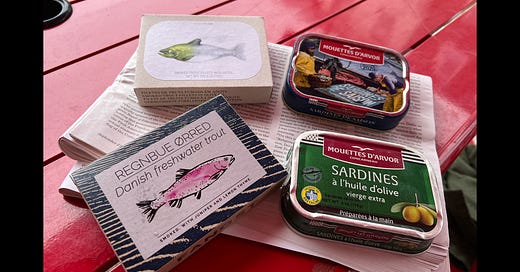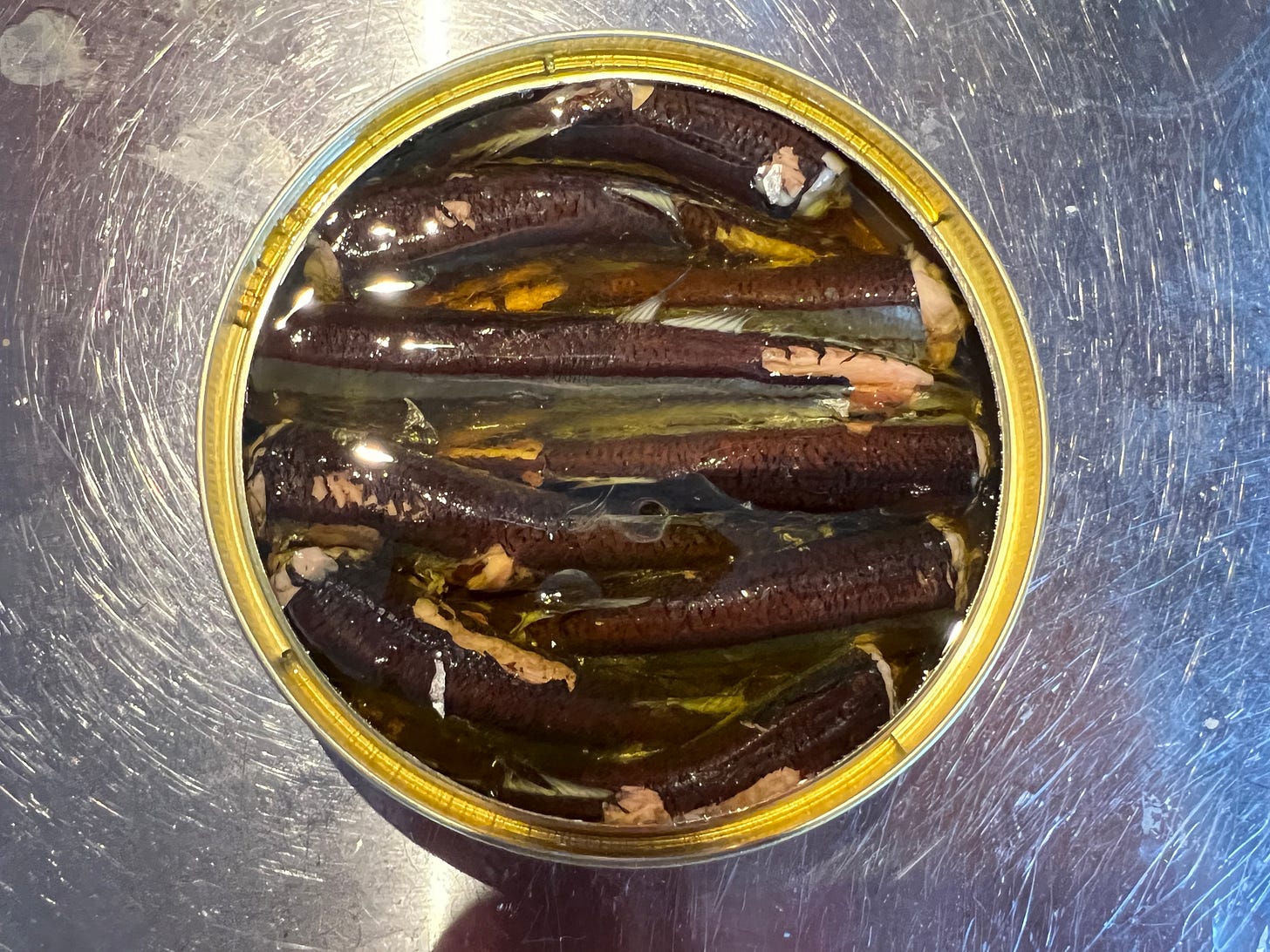
As far as I can tell, up until a few weeks ago I was one of the last few dozen people in the United States who had yet to “get into beans.” I’m not sure this makes much sense, since someone who routinely eats $10 tins of fish guts for lunch would, you’d think, be open-minded about an expensive version of a pantry staple, but skepticism of a spate of people seeming to performatively substitute bean consumption for a personality (said the resident of a glass house, wielding his rock) and, more basically, of $8 bags of beans kept me in the darkness until, on a whim, I bought a bag of Rancho Gordo pinto beans at a fancy-goods store in the Philadelphia suburbs and saw the light.
Naturally, the first thing I did with my fancy beans was have them with sardines, and it was a revelation; the biggest problem I’m having is that I don’t especially want to eat anything else for lunch, nor is there any real reason to, since a bowl of brothy beans and fish and vegetables gives you pretty much everything you need and can easily be changed up every day so you don’t get bored of it. It also has some secondary benefits I find useful, like being a good way to use lesser sardines (the beans make a worthy backdrop to your finest tin, to be clear, but are also rich and flavorful enough to compensate for the flatness of a mediocre tin in a way that even really good rye or sourdough isn’t) and easy to make ahead of time (a pound of dried beans makes enough for a weeks’ worth of lunches and doesn’t take up too much space in the fridge). Here is how I do that:
I start with about a half pound apiece of coarsely chopped carrots, celery, mushrooms, and onions, and will throw in other stuff, like leek greens or tomatoes, in about the same quantity if I have extra I want to use up or just have some laying around. (One thing I’ve learned over the years is that vegetable-trimming stock based on frozen scraps is a lie—or, if not a lie, not worthy of the claims people make for it; it’s always satisfying to make something edible out of what otherwise would have been compost, but if you want something really good it helps to start with good, fresh ingredients, rather than semi-garbage.) I heat some oil over medium heat, toss a couple of small-to-medium chili peppers and at least five big, smashed cloves of garlic in with the vegetables, and sauté until the onions are translucent, then add a Parmesan rind, a dried ancho, a lot of black pepper (I don’t add salt because that comes later, when cooking the beans), a couple of big pinches of dried thyme, and 10 cups of water. Then I put a lid on, bring it about up to a boil, lower it to a low simmer, and leave it alone for an hour, after which I strain it and stick it in the fridge (or leave it on the counter) for a while to chill (or cool down a bit).
Once I’m ready to make the beans I just rinse them, toss them in a big pot, and cover them with the broth by about two inches. (This should leave over about two cups, most of which you’ll end up adding to the pot to replace evaporated liquid.) Then I add a fair amount of good chili powder, a bay leaf, a strip of rinsed kombu, and a lot of cumin (as in I add too much cumin, then add some more), and bring it all up, uncovered, to a hard boil. At this point I add in three tablespoons of my second-best olive oil, let it boil for 15 minutes, and bring it down to “bubbles barely breaking the surface” heat with the lid on the pot but ajar. Then I let it go, checking every half hour or so to give a gentle stir and see if I need to add just a bit more of the stock; after about an hour, the beans are starting to get tender, at which point I salt it (you can salt whenever you want, and while I use very little, if you’re more into it maybe about a tablespoon) and add a bit of liquid if it needs it. (This is also a good time to fish out the kombu if you haven’t yet, since it can dissolve in the beans if left too long.) Depending on the kind of bean—I use pintos, black beans, and pinquitos, from Rancho Gordo, which tend to take about two and a half hours in all, and find ones from the bulk bin at my local hippie store can take considerably longer—it can take anywhere from another half hour to several hours for the beans to be done. What “done” is is a matter of taste once they’ve reached a certain tenderness; I like to leave them until they’re pretty tender and just covered by a saucy broth and mash some up with a masher, then squeeze about a third of a lemon in and add a little liquid and let them go another 10 or 15 minutes.
Anyway! Now you have some beans, firm and creamy and piquant and potentially with a bit of a kick depending on what kind of chili peppers you used and as different from a perfectly fine can of beans off the shelf as a truly fine tin of fish is from one you’d find at a gas station. I pour a cup over a handful of spinach in a big bowl and add half an avocado, red pepper slices, green onions, and a drained tin of sardines, breaking the poor creatures’ corpses up into bite-sized chunks and distributing them like chunks of franks in franks-and-beans (a food I remember fondly from childhood and on some level hope is no longer familiar to our nation’s youths) if it’s a lesser tin and leaving them intact on top of the beans if it’s a greater one, in the latter case savoring the sardines by the half with just a bit of beans and vegetables on each forkful. The smokiness of a good sardine is a near-perfect complement to the beans, and if the weakness of the dish is its lack of textural contrast (something peppers and green onions can only go so far in mitigating), a firm sardine is still quite distinct from the beans. Mussels and mackerel also go well with beans prepared this way. I’m going to try some trout tomorrow.
Housekeeping
—Speaking of trout, while I’ve threatened this before, I’m going to try to write this newsletter more often; there are books about tinned seafood that are worth writing about, and many varieties of fish that I’ve enjoyed recently. For a while I was hung up on writing about some garfish, which I really disliked even though rationally there was no reason to (they were firm, meaty little tubes of oil, which describes sardines). I felt guilty about writing about something I disliked when there are so many good tins to write about, especially when this was something I disliked because I disliked it and not because it was bad, and then guilty about not finishing something I’d started, and the end result was writing nothing. Terrible! Here’s what I wrote about the garfish before I gave up, and a photo of them:
One of my many weaknesses as a tinned-seafood enthusiast is that I’m squeamish. I don’t want to see, let alone eat, the beady eyes of baby eels; the sound alone of the word “geoduck” is enough to put me off the idea of ever trying it; I regard any kind of sea life I haven’t had as presumptively repulsive; and I generally understand why some people are incredulous at the idea of regarding small Mediterranean sea creatures preserved in oil or brine as delicacies. What makes things worse is that I often come across vile, noxious foods—a pricey scorpionfish paté the color and consistency of cheap cat food that expresses its fishy essence with the intensity espresso does coffee, for instance, or quality mollusks drowned in thin, syrupy oils that taste like something that would sluice from a synthetic android. I regard new things with suspicion.
Lately, I’ve been tormented by a tin of XXX brand garfish in olive oil I bought on a whim months ago. I keep cans of seafood stacked a bit above eye level in my pantry, where I pass them probably dozens of times a day, and while it would be a bit much to say that the more I passed them the more the garfish operated as a kind of resonant novelistic symbol of my increasing unwillingness to try new things, they were definitely looming at me every time I went to get some eggs.
—I’ve really enjoyed the first two episodes of this season of Articles of Interest. It’s (broadly) about Ivy style, which was the subject of Black Ivy: A Revolt in Style, one of my favorite books from last year. I would definitely recommend either.




